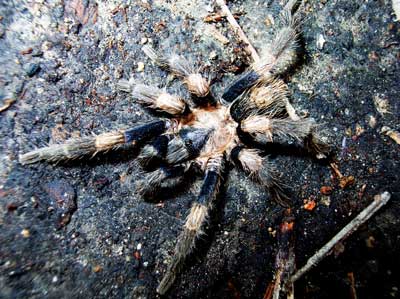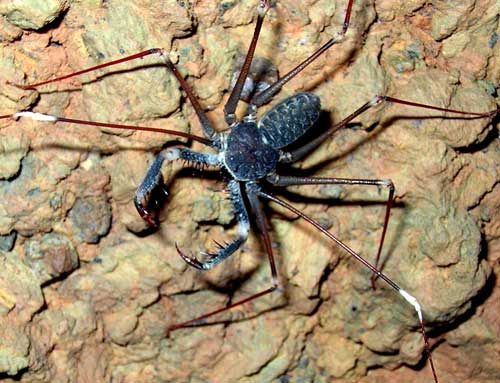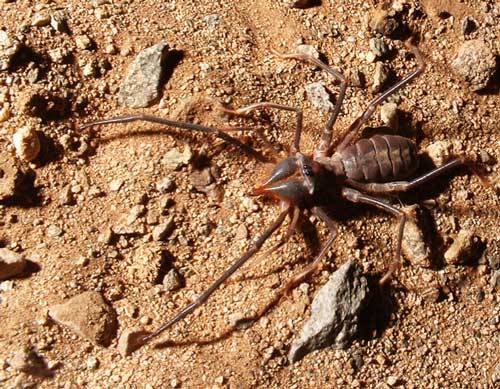 TARANTULA
MAN
TARANTULA
MANby John and Susy Pint
 TARANTULA
MAN
TARANTULA
MAN
by John and Susy Pint
Photos and text ©2008 by John & Susy Pint
Updated December, 2013
Biologist Rodrigo Orozco shares his home with thousands of tarantulas
and hundreds of scorpions.
He’s a man with a mission. “I want to end
the illegal trade in Mexican tarantulas,” he told us. “My goal is to
produce 6000 tarantulas per year and eventually flood the black market
so that tarantula poaching will no longer be a lucrative business.”
Tarantulas belong to a class of invertebrates called arachnids, which
have eight legs. There are around 70,000 species of arachnids,
including spiders, scorpions, daddy longlegs, ticks and mites.
Tarantulas, of course, are spiders, famous for being long-lived. Their
bodies are completely covered with short hairs and their leg spans can
reach up to twelve inches. Brazil leads the world in the number of
different species and Mexico is in second place.
 Tarantulas
in the Americas have a dense covering of extremely fine irritating
hairs at their back end. These have tiny barbs and produce a burning
itch in human skin. When angered, the Tarantula can turn around and
shoot these nearly invisible missiles at an enemy. However, generally
speaking, they are very docile and one can pick them up without fear.
Mexican tarantulas—in particular the Red-Legged Tarantula, Brachypelma
smithi—are noted for their docility. They can inflict a painful bite,
since their fangs can pierce human skin, and they do have venom glands,
but the bites of New World tarantulas are considered non-toxic to
humans and there have never been any deaths reported as a consequence.
Tarantulas
in the Americas have a dense covering of extremely fine irritating
hairs at their back end. These have tiny barbs and produce a burning
itch in human skin. When angered, the Tarantula can turn around and
shoot these nearly invisible missiles at an enemy. However, generally
speaking, they are very docile and one can pick them up without fear.
Mexican tarantulas—in particular the Red-Legged Tarantula, Brachypelma
smithi—are noted for their docility. They can inflict a painful bite,
since their fangs can pierce human skin, and they do have venom glands,
but the bites of New World tarantulas are considered non-toxic to
humans and there have never been any deaths reported as a consequence.
| Tarantulas have eight eyes but can only distinguish
light and dark and movement. They spend most of their lives in their
burrows waiting for something tasty to pass by, but males venture forth
during their last year of life in search of females with whom to mate.
|
 |
At present, a full-grown tarantula can fetch several hundred dollars on the black market and, because Mexican tarantulas make ideal pets, thousands are illegally shipped to Germany, the USA and other corners of the world. “People don’t realize that a female tarantula may only produce four surviving adults during her entire life. The poaching that’s going on will wipe them out unless something is done.”
|
Unfortunately, Orozco’s project to flood the market with inexpensive and legal tarantulas will not make an impact for years. This is because it takes more than 20 years for these spiders to reach the large size which customers prefer “for scaring their mothers-in-law.” The oldest of the many thousands of tarantulas in Orozco’s home are only five years old, still too small to be attractive to buyers, but Orozco foresees a day when tarantula traffickers will be out of a job.
|
 |
Fortunately, Rodrigo Orozco is no longer alone in the fight to save
Mexico’s tarantulas. “Two other biologists—in Cancún and in Puebla—are
now breeding tarantulas for this same project,” he says with a smile.
“The tide is turning.”
 
The Tarantulas de Mexico Project is supported by the government, but gets no funding from it! Instead, it survives mainly through the sale of T-shirts and caps. These are available directly from: Rodrigo Orozco, Tel: 36 41 68 74 Email:
Qtarantulasmexico@yahoo.com.mx
Xela Lloyd (left) and Angélica Arrevalo (right) model the T-shirts that keep this project going. And check out the cool "gorra" below. |
OTHER CURIOUS ARACHNIDS
SCORPIONS
| You can find 221 of the world's 2000 species of
scorpions in Mexico, which holds the dubious honor of having more of
its people stung by scorpions per year than any other place on earth.
The Nahuatl word for scorpion is "colotl" so Colotlán means "Place of
the Scorpions."
|
 |
VINAGRILLOS & TENDARAPOS
| Another interesting arachnid is the vinegaroon (Mastigoproctus giganteus), called vinagrillo in Spanish. With their scorpion-like claws and a tail that looks like an upraised needle, you can understand why many campesinos believe not only that their sting is deadly, but that even their shadow is mortal. Actually, the worst these fearful-looking creatures can do is spray you with vinegar, for they are completely harmless to humans. Their cave-dwelling cousins (Acanthophrynus coronatus) are known as tendarapos (or tindarapos), canclos or limpia casas (house cleaners) in Spanish and “tailless whip scorpions” in English. They have lost the tail and the acetic-acid spray and, despite their misleading name in English, are utterly harmless. You’ll find plenty of tendarapos creeping about inside the caves of the warmer parts of Western Mexico.
|
 |
CAMEL SPIDERS
|
One more bizarre arachnid is the camel spider, also known as wind spider or matevenados (deer killer) in Spanish. These look scary because they have the largest fangs in the world (in relation to their body size). New recruits fighting in Iraq constantly hear tales of these creatures leaping into the air, racing along at supersonic speeds, disemboweling camels, etc. The truth of course, is something quite different. These are Solifugae (meaning those who flee the sun) and are probably called camel spiders simply because a camel saddle sitting on the ground provides the shade they so much love. They are, in fact, not poisonous at all, but they can be aggressive and their bite (like the bite of anyone with a dirty mouth) might result in infection. |
 |
|
|